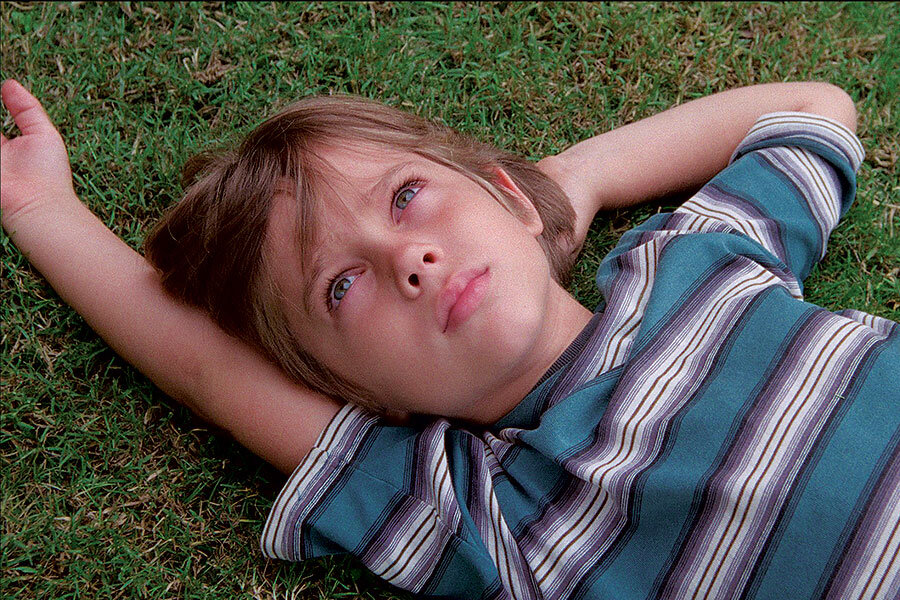'Boyhood' shows that director Richard Linklater is the most gifted director of his generation
Loading...
I have long maintained that Richard Linklater is the most gifted and audacious director of his generation. His new movie, “Boyhood,” which runs 2 hours and 44 minutes, is a stunning reconfirmation. Shot during 39 days over a stretch of 12 years, it dramatizes the life of a Texas boy, Mason, as he ages from 6 to 18. Mason is played by Ellar Coltrane, who had never acted before. He grows up before our eyes. No CGI, no trickery of any kind – just the stark serenity of observing aging at work.
The featured actors all went along for the 12-year ride: Patricia Arquette as Olivia and Ethan Hawke as Mason Sr., the boy’s divorced parents; and Lorelei Linklater (the director’s daughter) as Mason’s slightly older sister. Much could have gone wrong here – the financing could have fallen through; Linklater’s scenario could have meandered nowhere interesting; actors could have dropped out of the project or even died.
The fact that the film, for the most part, is a triumph owes something not only to luck and Linklater’s tenacity but also to the very nature of the project itself. Linklater has always been captivated by the mysterious passage of time in his movies, no more so than in his great “Before” trilogy, filmed over 18 years and starring Hawke and Julie Delpy. But “Boyhood” is something else again: a movie about time’s passage that is itself an expression of that passage. It’s the ultimate time-travel movie into the future, a “flowing time sculpture,” in Linklater’s own words.
It would have been discordant if Linklater had ginned up the film with melodramatic twists. He is after something far more elusive – the way drama plays itself out in the mundane dailiness of its characters’ lives. He wants us to recognize that it is the small moments, and not the big, engineered ones, that impart a larger meaning to the whole. The film, in a sense, is a rebuke to the way Hollywood traditionally manufactures its entertainments, and yet it doesn’t come across as artier-than-thou. This is simply (and most profoundly) Linklater’s way of seeing. For him, the resonance of life resides in the quotidian.
The film’s exposition is linear, but there are large elisions in the story line. Olivia, single and seeking college-teaching credentials, moves her family around Texas, from Houston to San Marcos to Austin, acquiring and ditching two post-Mason Sr. abusive husbands along the way. (The adults in this movie are just as confused as the kids.) Mason goes from first grade to first love as a college-bound high school senior. Scenes glide into each other as the actors, looking somewhat older at each turn, pick up at different points in their characters’ lives. This technique keeps us off guard, but the progression is purposeful. To take just one example: The film begins with Olivia reading the first “Harry Potter” book to her two young children in bed. Some years later, the kids are lining up at midnight to buy “Harry Potter and the Half-Blood Prince.” After Mason, having in the interim acquired a sullen watchfulness, morphs into a teenager, his literary tastes turn to Kurt Vonnegut.
Linklater’s risks in this film are as much aesthetic as practical, and occasionally they don’t pay off. Sometimes banal is just banal. There are boring stretches during which I would have welcomed a little Hollywood hoo-ha. (Potential “big” moments, such as Olivia’s physical abuse at the hands of her alcoholic second husband, played by Marco Perella, happen off-screen.) Linklater’s dramatic technique here isn’t necessarily any more revelatory than more conventional methods employed by such film artists as François Truffaut, who, in his “Antoine Doinel” series, could transmit the passage into adulthood without taking 12 years to record one film. And for all the fascinations of seeing Coltrane come into his own, there were times when I wished a trained actor had played the maturing Mason. His performance, unlike those of most of the others, has documentary rather than dramatic power.
Linklater is certainly smart enough to recognize these aesthetic pitfalls. When he has a high school photography teacher chew Mason out by telling him that any jerk can take pictures but “it’s hard to make art,” Linklater is also implicitly throwing down the gauntlet for this film. Its faults are inseparable from its virtues, and are niggling beside them. There are moments that are extraordinarily affecting out of all relation to their brief time onscreen, such as the scene when Mason, before moving out of his childhood home, paints over the height marks on his bedroom wall. “Boyhood” is a movie that will, I expect, seem an even richer experience as it marinates over time in my mind. This has often been true for me with Linklater’s films, and I think it’s because his artistry is all about overtones – about the sounds we hear and the images we hold after the large chord has been struck. This movie is saying that, in the end, what is fleeting is what stays with us. Grade: A (Rated R for language including sexual references, and for teen drug and alcohol use.)







